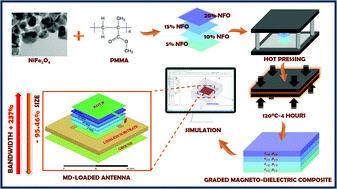Functionally graded magnetodielectric composite substrates for massive miniaturization of microstrip antennas†
Abstract
In the present work, an axially anisotropic magnetodielectric composite, based on polymethyl methacrylate (PMMA)–NiFe2O4 (NFO), was designed for realizing miniaturized antennas. The structural as well as ferromagnetic properties of the developed NiFe2O4via a polymer pyrolysis method were studied in detail. Thin sheets of (0–3) composites were developed by adding a different volume % of NFO (5, 10, 15, and 20 vol%) in the PMMA matrix. Structural, dielectric, magnetic and magnetocapacitance measurements were investigated for individual composites. A microstrip patch antenna operating at 830 MHz was theoretically modeled by stacking differently loaded MD wafers to form a functionally graded anisotropic composite, to be used as the antenna substrate. An impressive miniaturization of 95.46% was observed for this MD antenna, when compared to normal dielectric substrates with permittivity and permeability values equal to unity.



 Please wait while we load your content...
Please wait while we load your content...